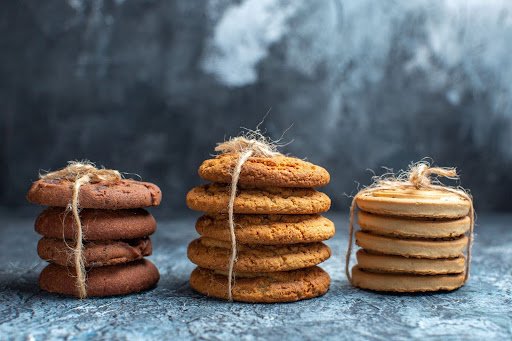
Cookies are not just cookies; they’re small morsels of texture magic. Some crumble apart in a crunch, others dissolve in your mouth. What does it all take? It all depends on the ingredients and baking secrets. Let’s decode the cookie secret, bite by bite.
Sugar Types and Cookie Texture
Sugar is not sugar; it’s texture masquerading. White sugar produces golden, crunchy borders, and brown sugar produces chewiness because it contains molasses. A combination of both? That produces a soft centre and crunchy border. Sweet heaven. Brown sugar’s water content holds the cookie together; white sugar allows spreading and crunching. If you want that soft, rich chew like edible cookie dough, use brown sugar. White sugar is your best bet if you can’t resist that bakery flavour anyway. The combination is what makes all the difference.
Butter: Melted vs. Softened
Butter is the key player of the cookie texture arena. Melted butter produces flat, chewier cookies, as it breaks down sugar and makes cookies spread faster in the oven. In the meantime, softened butter, creamed with sugar, catches air, producing cakier, more dense results. Want a lighter, golden rise? Beat the room-temperature butter thoroughly. Either way, your butter type is dictating the entire batch, so don’t mess it up.
The Role of Baking Time
Baking time is the determining factor. Your cookies will be soft and chewy even when they are chilled if you pre-bake them. They will be crunchy, especially on the edges, if you bake them a few minutes more. There is, however, a fine line between golden brown and burned. One minute or so too long in the oven can be the difference between that lovely soft centre and an over-crisp crunch. Watch for those ever-so-maybe golden edges and a just-set centre. Don’t wait for that perfect look in the oven; cookies keep cooking on the baking sheet.
Egg Ratios and Chewiness
Eggs add moisture, fat, and texture, but ratio plays a bigger part than you would think. The fat of the yolk melts completely and produces that melt-in-your-mouth feeling. Crisper edges and drier texture needed? Use a whole egg or lessen slightly. Egg whites dry things out a bit but also create that light, airy snap. Don’t just crack and toss; think about what your eggs are doing in there. They’re quietly shaping every bite.
Temperature Tricks for Texture
Heat is a subtle little game-changer. Baking marginally higher (about 190°C) at the fraction of a degree promotes speedy spreading, for gooey centres and crispy edges. Lower heat? You’ll get puffier, cakier cookies. But don’t get there; dough temperature matters as well. Warm dough spreads too rapidly, tending to flatten like pancakes. Cold dough is the way to go for a thick and well-shaped cookie. It’ll pre-melt the butter and ruin the texture. A cold tray and cold dough? That’s the power couple of an amazing cookie.
Why Chilling Dough Matters
Patience is a virtue; cold dough makes better cookies. Cooling companies up the fat, which slows spreading in the oven. That will bake more even, thicker, and deeper-flavored cookies with perfect golden edges. A fridge hour can be the difference. Let it sit overnight and the flour fully hydrates, resulting in a cookie with a soft structured bite. Ignore chill time and your cookies may bake up thin greasy or oddly shaped. Do not rush then. Put the bowl in the fridge set it aside for a bit and allow science to have its way.
Flour Choices and Crunch Factor
Flour lays the groundwork for texture. All-purpose flour is your best friend, crunchy and tender in a mix. But replace it, and your cookie is another world. Bread flour, with a higher protein level, adds an extra chew and hold. Cake flour? That’s your cookie stand-in for light and fluffy cookies. Too minute, cookies spread too thin. Just so, sifted to perfection, gives that ideal bite. It isn’t glamorous, but flour is pulling the load.
Conclusion
Your cookie varies with each change you make, from the level of sugar to baking time. Chewy centre or crunchy edge is up to your technique, mix, and patience. A seasoned pro produces outstanding cookies; they don’t magically occur.
As the writer and founder of this blog, I share insights on Tech, Business, Media, Games, Apps, Gadgets, Cybersecurity, Web Development, Podcasts, and Cryptocurrency. My mission is to educate and inspire with engaging, SEO-friendly content that keeps you ahead in the digital landscape.
